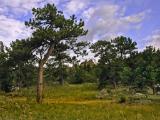Ponderosa Pine Ecosystem
What is it?
Romanticized in television, books, and film, the Ponderosa pine ecosystem is instantly recognizable to the many Americans who strongly associate these woodlands or “savannas” of tall, widely spaced pine trees with the mountains of the Southwest. .
Individual ponderosa pine trees (Pinus ponderosa) can live well over 500 years. Their extreme drought resistance stems from long “tap roots” that provide secure anchors that access soil moisture deep underground. Intolerant of shade from other trees, ponderosa pines are most successful in open sunlight.
The prevailing image of ponderosa pine woodlands and savannas spread across wide-open grasslands of the American Southwest is only partially correct. Healthy ponderosa ecosystems include a mosaic of dense patches of pine trees interspersed with grassy meadows at higher elevations, with large areas of more open savanna-like pine woodlands at lower elevations. This natural patchiness is a very important ecosystem character that no longer exists in most areas of this ecosystem.
Found throughout Rocky Mountain foothills, these ecosystems occur in dry, rocky habitats from the mountains of central Wyoming down through the Colorado Rocky Mountains into the mountains of New Mexico, and west into the mountainous plateaus and isolated mountains of Arizona and Utah. While they typically appear below the region’s other montane forests, in some mountain ranges the Ponderosa Pine ecosystem ‘zone’ spans some 4500 ft in elevation from the lowest stands to the highest.
On steeper, rocky slopes with little soil, a diverse suite of shrubs, grasses and herbs accompanies the ponderosa pines; in deeper soils, grasses become better established with the pines. At the higher (cooler) elevations, the woodlands can become more forest-like in character, inter-mixed with Douglas-fir (Pseudotsuga menziesii). In the warmth and relative aridity of lower elevations, they usually form open savannas of widely spaced trees.
Ponderosa pine woodlands and savannas are fire-adapted ecosystems. Mature trees have very thick bark and are well-adapted to the fast-moving fires that sweep through stands and burn grasses, pine needles, and low shrubs. Natural wildfires like this may naturally reoccur every five to 40 years at any single location, a frequency that significantly reduces the amount of fuel like tree branches, fallen trees and needle litter on the forest floor. Grasses and shrubs, however, can be abundant enough to sustain ground fires that kill tree seedlings and saplings. Mature pines survive these blazes, though, giving the ecosystem its characteristic appearance of large, tall, widely spaced trees with a grassy forest-floor and patches of shrubs.
Higher-elevation ponderosa pine woodlands have a natural fire pattern that is less frequent, allowing fuels of wood and needle litter to accumulate. Resulting fires are more intense, and, in some cases, “crown” fires can kill large patches of mature trees. Young tree seedlings then establish themselves on litter-free mineral soils and grow into dense patches of trees.





